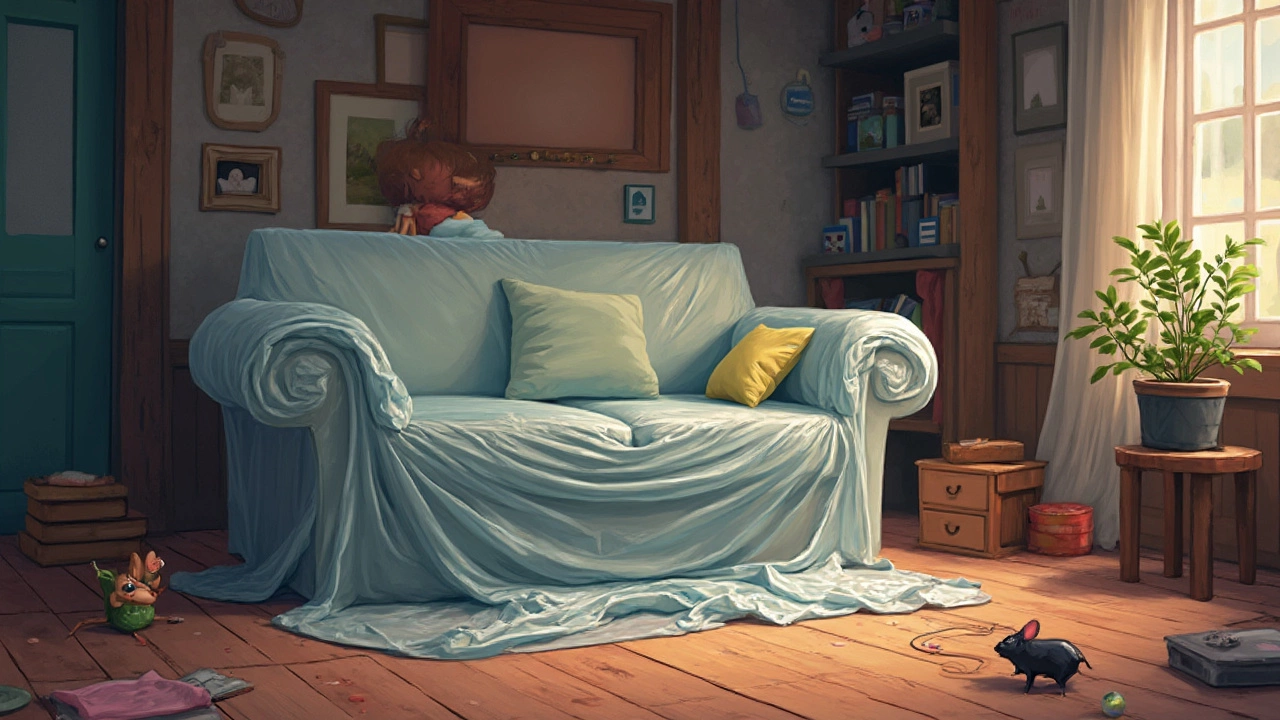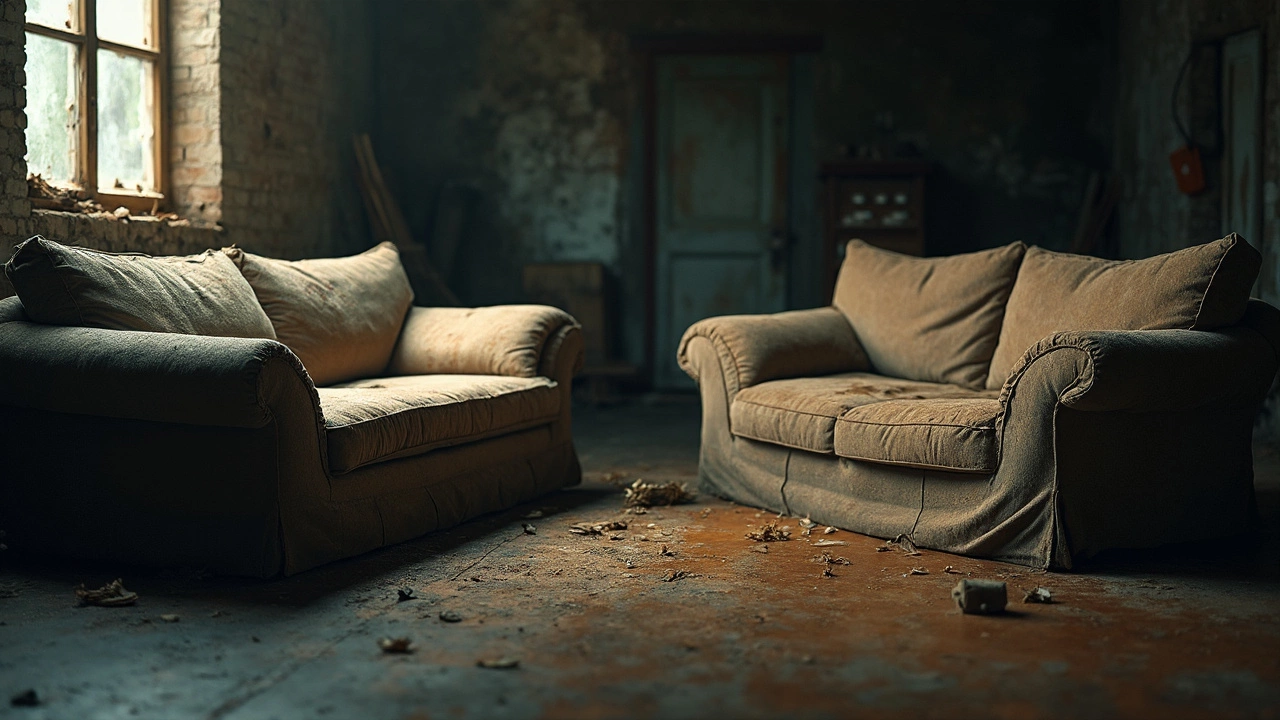So you’re staring at your couch, thinking about sticking it in storage, and wondering if wrapping it is just another hassle. Here’s the plain truth: unwrapped couches turn into dust magnets, odor sponges, and even bug hotels if you’re not careful. Whether you’re making space during a remodel, moving out, or just trying to keep Grandma’s sofa safe, wrapping matters more than it sounds.
Leaving a couch out in the open, especially in a storage unit, is basically asking for dusty armrests, musty smells, and unexpected stains. Even climate-controlled units won’t save you from every surprise. If you care about those cushions still feeling fresh (and not smelling like damp cardboard), a little prep goes a long way.
- Why People Wrap Couches for Storage
- Pros and Cons: Is Wrapping Always a Must?
- Choosing the Right Material for the Job
- Step-by-Step: How to Wrap Your Couch Properly
- Extra Tips for Long-Term Couch Storage
Why People Wrap Couches for Storage
No one really wants to deal with a trashed couch when they pull it out of storage. That’s the main reason so many folks wrap their couch up before it ever leaves their place. When you skip wrapping, even a few months in storage can turn a good sofa into a musty, stained mess. Dust, moisture, pests, and spills are the four main things to blame. Let’s break down why people don’t take chances with unwrapped furniture.
First up: dust is relentless. It sneaks into every little space and settles deep into fabric, making it tough to clean later. Wrap a couch and you’re blocking all that gunk. Next comes moisture. Even in "climate controlled" units, surprise leaks or humidity spikes can lead to mold growth and musty smells, especially if your storage place isn’t perfectly sealed.
Ever seen a chewed-up couch leg or weird stains you can’t explain? Mice, bugs, and spiders love storage spaces. Wrapping covers everything, so these pests don’t get in or nest under cushions. Some renters discover surprise bug infestations only after months—by then, the damage is done.
Wrapping also helps keep stains and tears away. Accidental bumps, leaking boxes, or stray paint cans can mess up exposed upholstery. If you’re storing your couch in a shared spot or a garage, there’s even more stuff banging around it, upping the risk.
- wrap couch storage protects against dust, moisture, and pests—basically everything that ruins a good couch.
- It keeps maintenance time down later since you won’t be scrubbing fabric or hunting for air fresheners.
- Your couch looks the same coming out as it did going in, without weird smells or mystery spots.
Check this out—one survey from a major national storage company found that over 70% of complaints involved soft furniture issues linked to moisture and dust. Protecting your couch with a wrap really is as practical as it sounds.
Pros and Cons: Is Wrapping Always a Must?
Honestly, wrapping your couch for storage feels like a no-brainer if you want it to come out looking (and smelling) the same as when you put it in. But is it really a must every single time? People store couches in all kinds of places—inside heated homes, musty garages, storage units with who-knows-what next door. Not every situation needs the same level of protection.
Let's break down the actual good and bad of wrapping:
- wrap couch storage keeps out dust, bugs, and pet hair. Nothing attracts spiders and moths quite like furniture fabric.
- Plastic wrap shields against moisture, but if you seal it too tight and there's humidity, you can trap it inside, which may lead to mold. If you live in a humid area, this matters. According to storage experts, mold risk jumps up to 80% in areas without good airflow.
- Wrapping—especially in sheets or blankets—keeps out scratches and dents during moves. Ever tried moving a leather couch through a doorway without protection? Good luck avoiding scuffs.
- If you’re using long-term storage, unwrapped couches pick up weird smells. The fabric just soaks up whatever’s in the air, from paint fumes to musty basement scent.
On the flip side, there are a few downsides:
- Not all wraps are equal. Thin plastic tears easily, and if you use the wrong kind, you risk trapping moisture instead of blocking it.
- Wrapping can take up extra time and—let’s be real—most folks don’t enjoy spending another hour prepping furniture when there’s a moving truck waiting.
- You might spend a bit of cash on the right materials. Good moving blankets and quality wrap aren’t free.
The big question—should you always wrap? If you’re storing your couch in a clean, climate-controlled room for just a few days, you can probably skip the full wrapping process. But garages, sheds, outdoor units, and anywhere with temperature swings? Wrap it for sure. Even a couple of weeks in a dusty spot can mean hours spent cleaning later. A stat worth knowing: Nearly 70% of people who skipped wrapping reported needing to clean stains or odors off afterward.

Choosing the Right Material for the Job
Not every wrap is created equal. Some folks just toss an old sheet over their couch and call it a day, but that move doesn’t cut it if you actually want your couch to survive storage in good shape. Picking the right material is half the battle in keeping your couch clean, dry, and safe from damage.
Here’s what actually works:
- Plastic wrap (stretch film): This stuff sticks to itself and keeps moisture, dust, and bugs out. It’s cheap and you can get it in big rolls from moving supply stores. But don’t wrap tight if your couch is leather or velvet––it needs to breathe a bit to avoid trapping mildew.
- Moving blankets: These are basically thick, padded quilts. They shield against scratches, dings, and a surprising amount of dust. Use them under plastic so air still gets in but dirt doesn’t.
- Furniture covers: You’ll find covers made specifically for storage—usually breathable, heavy-duty fabric. Not as cheap as plastic, but they protect from dust and let air circulate, so less risk of musty smells.
If your couch is going into a damp basement or non-climate-controlled unit, stick on a layer of moving blankets under plastic wrap for extra safety. A quick rule of thumb: use plastic if you’re worried about pests or water, and favor fabric if air flow matters more (think leather or natural fibers).
Here’s a pro tip from Mike D., a warehouse manager with twenty years on the job:
“The best option is always a furniture blanket first, then a layer of plastic. Taping the plastic right to the frame means even if there’s a spill or leak, your couch stays dry.”
Just skip regular garbage bags or thin cling wrap from the kitchen. They rip easily and trap too much moisture, setting you up for a smelly surprise later on. One more thing to make life easier: label wrapped couches with masking tape if you’re storing more than one. No sense unwrapping everything just to find the right piece.
Here’s a quick table comparing the main materials:
| Material | Blocks Dust | Prevents Moisture | Lets Air In | Protects from Scratches |
|---|---|---|---|---|
| Plastic Wrap | Yes | Yes | No | No |
| Moving Blanket | Yes | No | Yes | Yes |
| Furniture Cover (breathable) | Yes | Some | Yes | Some |
When it comes to protecting your furniture, taking the time to pick the right wrap saves you way more hassle down the road. Pile on the right wrap couch storage combo and future-you will be grateful.
Step-by-Step: How to Wrap Your Couch Properly
If you’re set on keeping your couch in solid shape during storage, following the right steps makes all the difference. Here’s what really works when it’s time to wrap your couch for storage. It won’t take all day, but doing it right means fewer regrets down the road.
- Deep clean before you wrap. Break out the vacuum and take care of crumbs, dust, and dirt. If there’s any spill or stain, spot clean it now—trapped messes can attract bugs or cause stains to set even deeper while the couch sits in storage.
- Take off loose parts. Remove cushions, legs if possible, and any pillows. Wrap cushions separately for better protection and to make moving the couch easier.
- Wrap with soft fabric first. Old sheets, moving blankets, or even large towels work here. This soft layer protects against scratches and lets the couch breathe a bit.
- Seal with plastic wrap (the right way). Use stretch plastic wrap or shrink wrap. Don’t wrap it too tight—tight plastic means zero airflow, which can trap moisture and cause mold. If you’re using a storage unit that’s not climate controlled, think twice about using plastic over the entire couch. For humid places, leave some gaps, especially on the bottom.
- Cover every angle. Make sure the whole piece is covered—even the legs and underneath. Pay attention to the corners; these take the most hits during a move.
- Label your parts. If you took off the legs or screws, put them in a labeled bag and tape that to the couch frame. Future you will be grateful.
- Double-check. Once it’s wrapped, give the couch a once-over to make sure every surface has protection. If anything’s sticking out, add another sheet or layer of wrap.
If you want to get it really right, here’s what movers and storage pros recommend for different couch types:
| Couch Material | Recommended First Layer | Best Wrap Method |
|---|---|---|
| Leather | Cotton blanket or sheet | Wrap loosely with plastic; avoid taping directly to leather |
| Fabric/Cloth | Any soft, clean fabric | Plastic is fine, but leave breathing room in humid areas |
| Microfiber | Soft blanket | Plastic wrap, but check for moisture; mold loves microfiber |
Don’t skip the prep work and assume the wrap alone will save your couch. A bit of time upfront means you won’t pull your couch out of storage to find a smelly or scratched mess.

Extra Tips for Long-Term Couch Storage
If your couch is going to hang out in storage for months or even years, a bit of prep makes a massive difference. Even when you’ve wrapped it, there are a few steps folks often miss—ones that can keep your furniture looking (and smelling) as good as new when you finally bring it back home.
First, clean your couch all over before wrapping. Even a small crumb can attract bugs or start mold if moisture sneaks in. Use your vacuum’s upholstery attachment and spot clean stains with a fabric-safe cleaner. Let it dry completely—seriously, a damp couch invites big problems.
Pick somewhere up off a concrete floor for your couch. Concrete sucks up moisture from the ground, which will transfer right into furniture over time. Put down some wooden pallets or sturdy plastic blocks. This keeps your couch drier and helps with air flow.
Pay attention to temperature and humidity. Even if your spot’s indoors, rapid changes in temperature cause materials like wood and leather to swell and shrink. If you don’t have climate control, invest in moisture absorbers like silica gel packs or DampRid buckets. Here’s a quick comparison of storage environments and risks:
| Storage Type | Risk of Moisture Damage | Pest Problem Risk |
|---|---|---|
| Climate-Controlled Unit | Low | Low |
| Garage/Basement | High | Moderate |
| Outdoor Shed | Very High | High |
If you’re stacking stuff (like other boxes or lighter furniture) on top, don’t. Couches will sag or get deformed if something heavy sits on the cushions for too long. Always store your couch upright on its feet.
One final tip: come back and check on things. Every couple of months, go into storage, peel back the wrapping, and make sure nothing’s getting weird. Smell, touch, and look for any early trouble. Fixing a small spot of mold or catching a mouse before it nests is way easier than dealing with a ruined couch down the line.
Take these small steps and that wrap couch storage process will pay off. Nobody wants their couch to become a science experiment while in storage—and with a bit of planning, yours won’t.


Write a comment